
by Timothy Oleson Wednesday, July 6, 2016
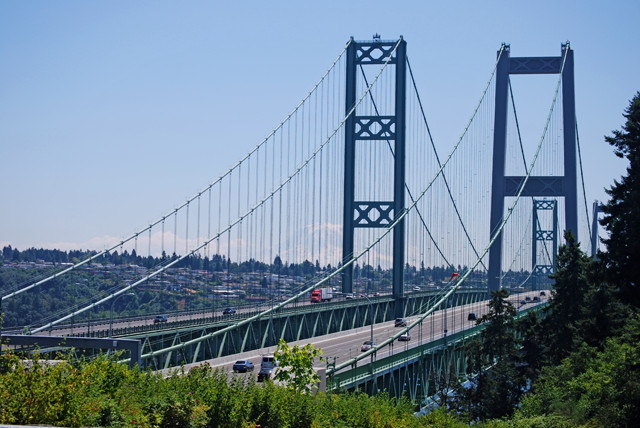
©Washington State Department of Transportation, Creative Commons Attribution-NonCommercial-NoDerivs 2.0 Generic
Washington’s Puget Sound comprises an intricate network of rivers, lakes, inlets and islands, many of which are traversed by bridges that safely carry more than 100,000 cars each day. With November upon us, however, civil engineers and Department of Transportation officials in Washington must be holding their collective breath. Historically, the 11th month has not been kind to area bridges.
Opened to traffic on back-to-back days in July 1940, the Tacoma Narrows Bridge and the Lacey V. Murrow Memorial Bridge 40 kilometers to the northeast were both considered spectacular, albeit distinctly different, technical achievements. Whereas the former was a lithe suspension bridge that arched nearly 60 meters above its namesake channel, the latter was draped low across Lake Washington, floating on air-filled pontoons. Ultimately, though, the bridges would suffer the same fate. Under duress from November storms, one collapsed just months after opening, followed some 50 years later by the second.
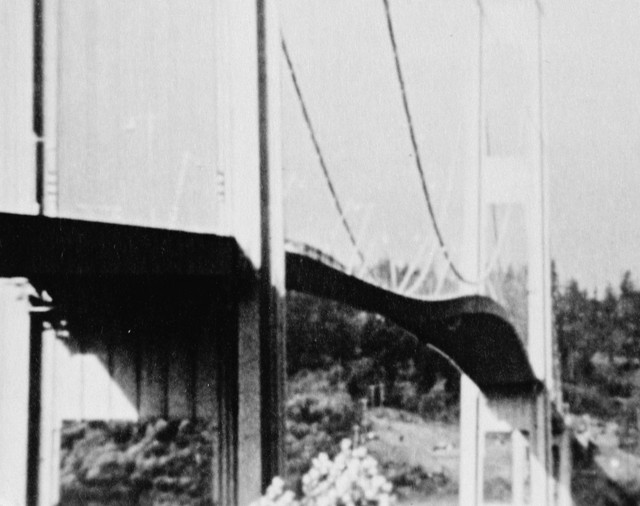
Oscillations on the Tacoma Narrows Bridge, Nov. 7, 1940. Credit: Library of Congress Prints and Photographs Division.
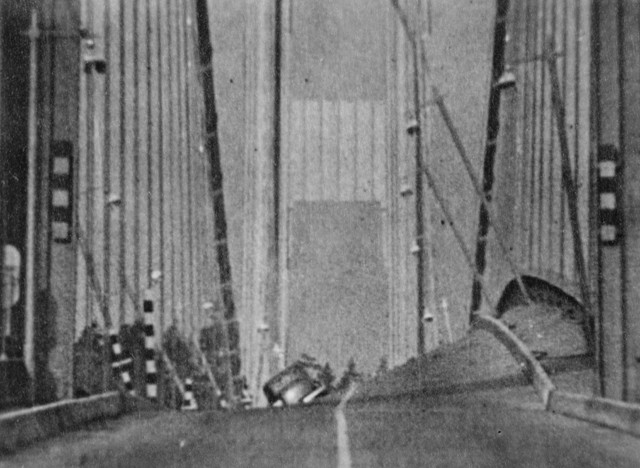
With newspaper editor Leonard Coatsworth's car still on the deck, vertical and torsional motion was recorded on the Tacoma Narrows Bridge, Nov. 7, 1940. Credit: Library of Congress Prints and Photographs Division.
Originally dating to the late 19th century, the idea to build a bridge to span the 1.4-kilometer-wide stretch of Puget Sound between Tacoma to the east and the small fishing town of Gig Harbor to the west wasn’t seriously considered until the 1920s. As the automobile increased in popularity, a bridge was seen as the logical step to drastically decrease the travel time from one side of the sound to the other. The driving distance between Tacoma and Gig Harbor would decrease from 172 to just 13 kilometers. The bridge would also link McChord Air Field near Tacoma with the Navy shipyard in Bremerton, an important step from the U.S. military’s perspective and one that helped secure funding for the project. After more than a decade of planning and fundraising, the project finally began to take shape in 1937.
The state’s bridge engineer, Clark Eldridge, had drafted a “tried and true conventional” design for the bridge on behalf of the state highway department and the Toll Bridge Authority. To Eldridge’s chagrin, however, the federal Public Works Administration, which was the project’s principal financier, insisted that bridge engineer Leon Moisseiff be hired as the lead consultant and designer.
Moisseiff had become famous for his innovative contributions to earlier suspension bridges, including the Manhattan and Golden Gate bridges, and he was determined to use the most contemporary design theory, known as “deflection theory,” at Tacoma Narrows. This meant a lighter, narrower, more flexible and less expensive structure. Instead of an almost 8-meter-deep frame of crisscrossed trusses that Eldridge recommended and had been used previously for the Golden Gate Bridge, the Tacoma Narrows deck would be supported by a pair of plate girders — solid steel beams running the length of the bridge along the underside of the roadway — each only about 2.5 meters deep.
Despite the challenges posed by the narrows — including swift currents and the 60-plus-meter depth that necessitated the deepest piers ever built — construction of the bridge, which began in fall 1938, took only 19 months. When finished, the Tacoma Narrows Bridge had an 853-meter-long center span, a little shy of half the total length, making it the third-longest suspension bridge at the time behind the Golden Gate and George Washington bridges. It also featured the smallest-ever width-to-length ratio at 1-to-72.
Even before the bridge was completed, workmen noticed that when winds picked up, the bridge’s deck shook in a wave-like vertical motion. The motion, which earned the bridge its now-infamous nickname, “Galloping Gertie,” continued after the bridge opened on July 1, 1940. State officials were concerned. To address the bouncing, the Toll Bridge Authority enlisted the aid of University of Washington engineer F.B. Farquharson, who suggested adding stabilizing cables; temporary ones were added that October, but they proved ineffective. In early November, after one of the temporary cables had snapped, Farquharson recommended two alternative solutions: cut holes in the deck girders to allow wind to pass through them more easily, or place rounded fairings over the girders to deflect the wind. The state chose the second option, but never had a chance to implement it.
Early on Nov. 7, 1940, about four months after it opened, southwesterly winds — with gusts eventually reaching 68 kilometers an hour — began buffeting the side of the bridge as traffic continued across it. The deck began its customary rippling, bouncing up and down with more than a meter of displacement from its normal position at times. Traffic was eventually halted as a precaution. As the last two vehicles made their way onto the bridge shortly after 10 a.m., however, the bridge’s vertical movement was supplemented by a twisting motion that whipped the deck up and down to either side of the center of the roadway. The twisting grew increasingly severe, such that one sidewalk was 8.5 meters higher than the other at times.
Terrified, the motorists caught on the bridge, including Leonard Coatsworth, an editor with the Tacoma News Tribune who was on his way west with his daughter’s cocker spaniel, Tubby, scrambled from their cars. “I jammed on the brakes and got out, only to be thrown onto my face against the curb,” Coatsworth later recalled, according to the Washington State Department of Transportation’s online history of the bridge. “Around me I could hear concrete cracking. I started back to the car to get the dog, but was thrown before I could reach it. The car itself began to slide from side to side.”
As crowds of onlookers, including Clark Eldridge, who arrived at 10:15 a.m., and Farquharson, who was actually on the bridge when the twisting began, watched, the bridge began collapsing. Suspension cables snapped loudly; the steel girders bent and twisted like taffy; and pieces of concrete broke free from the deck. At 11:02 a.m., a 180-meter portion of the center span gave way, crashing into the water below. Additional sections followed. When the last major section fell at 11:10 a.m., most of the center span was gone, leaving behind dangling suspension cables, a gaping hole between the two towers and sagging side spans at either end of the bridge.
Amid the chaos, Coatsworth and the other stranded motorists had managed to get off the bridge. A last ditch effort by Farquharson and another man to save Coatsworth’s dog failed, however. Tubby was the only death in the calamity.
A phenomenon known as aeroelastic, or torsional, fluttering, is the generally accepted cause of the Tacoma Narrows Bridge collapse, although other hypotheses have been suggested as well. In the end, the bridge’s flexibility and smaller, solid plate deck girders, both of which were touted as strengths in the initial design, evidently led to its demise. Rather than letting the wind pass through unimpeded, the girders absorbed the brunt of repeated gusts, instigating the twisting motions that became so severe due, in part, to the lack of rigidity in the deck. In a violent positive feedback, the momentum of the twisting grew as adjacent sections of the bridge rotated in opposite directions, feeding off each other with each twist before the strain became too great for the towers and suspension cables to bear.
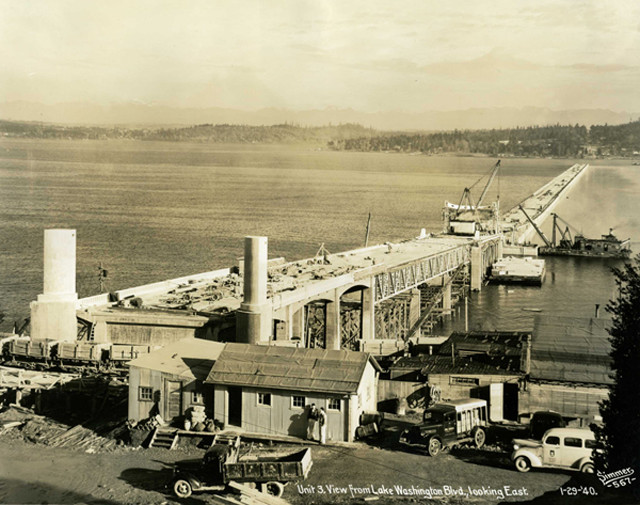
The view looking east from Seattle toward Mercer Island on January 29, 1940, during construction of the first Lake Washington Floating Bridge, later renamed in honor of Lacey V. Murrow, the state's highway department director at the time. Credit: Washington State Archives.
Like the Tacoma Narrows Bridge, the Lake Washington Floating Bridge, as it was originally known, was promoted beginning in the 1920s as a way to connect communities that, although geographically close, were a long drive apart. In this case, it was bustling Seattle and the small towns east of the city that state officials wished to unite.
Construction began in early 1939 on a bridge design by engineer Homer Hadley. The combination of the lake’s depth — 65 meters at its maximum — and its unstable muddy bottom precluded a traditional bridge with fixed piers, so Hadley came up with what he called a “floating concrete highway, permanent and indestructible, across Lake Washington.” Completed in 1940, the reinforced concrete roadway rested atop 22 hollow concrete pontoons that were tethered to each other and anchored to the lake bottom with weights. Spanning 2,020 meters, it was the longest floating bridge in the world when it opened on July 2, 1940.
Although far less eye-catching than Galloping Gertie, the Lake Washington Floating Bridge proved far more durable. In 1967, the bridge was renamed in honor of Lacey V. Murrow, director of the state’s highway department during the construction of both the Tacoma Narrows Bridge and the Lake Washington Floating Bridge (and older brother of famed newsman Edward R. Murrow). Eventually, after decades of wear and tear, and steadily increasing traffic volume, the bridge required attention. Following completion in 1989 of an adjacent floating bridge, named for Hadley and intended to ease congestion crossing the lake, the Murrow Bridge was closed for maintenance and upgrading.
During repairs, workers were not allowed to dump wastewater into the lake for fear of contaminating it. They needed space, though, to hold this water during construction before it could be removed and disposed of later. So, the workers opened hatches on the floating pontoons, which had been deemed capable of holding the necessary volume of wastewater without sinking. When repair work stopped temporarily for the Thanksgiving holiday weekend, however, the pontoons were left open.
Beginning on Nov. 22, 1990, Thanksgiving Day, high winds and heavy rains lashed the area for three days. As was later determined, the still-open pontoons, some of which were already partially filled with wastewater, were further filled with rain and splashing surf from the unusually choppy lake. By midday Sunday, with the pontoons acting like lead weights pulling on the roadway above, the bridge began to sink. Efforts to pump water from the overfilled pontoons proved futile.
As news cameras rolled and television viewers watched live, the bridge slowly broke apart as first one pontoon sunk, then another, and another, each dragging massive chunks of the reinforced concrete below the gurgling water surface. Likened to the Titanic because of the slow pace at which it went down, it was late Sunday before most of the bridge was gone. The few people who were on the bridge when it started sinking made it off safely so that no human casualties resulted from the failure.
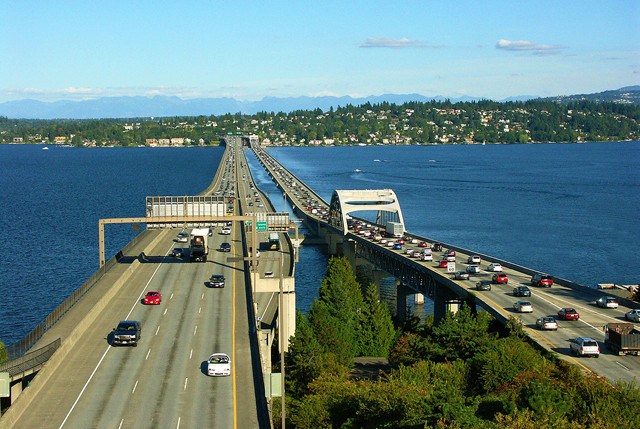
The modern view looking east from Seattle toward Mercer Island: Interstate 90 traffic flows across both the Homer M. Hadley Memorial Bridge (left), completed in 1989, and the Lacey V. Murrow Bridge (right), which sank in 1990 but was rebuilt and reopened in 1993. Credit: ©parafl yer, Creative Commons Attribution-NonCommercial-ShareAlike 2.0 Generic.
Both cases served as potent lessons for future bridge-building projects. Still seen as one of the most iconic bridge failures, the collapse of the original Tacoma Narrows Bridge laid bare the need to account for the potential effects of wind and weather. Suspension bridges built after 1940, including the second Tacoma Narrows Bridge, dubbed “Sturdy Gertie” and opened in 1950, were built wider and sturdier, while older bridges were retrofitted for added stability. A third bridge over the narrows, parallel to the second, which still functions today, was completed in 2007 to handle increased traffic load. The Murrow Bridge over Lake Washington was also rebuilt and opened in 1993.
Despite the lessons of these and other failures, bridge construction and maintenance remains challenging. The collapse of the westbound Interstate 35 bridge near Minneapolis, Minn., in 2007, which resulted in 13 deaths and more than 100 injuries, is a recent reminder of this.
The American Society for Civil Engineers’ (ASCE) 2009 Report Card for America’s Infrastructure gave U.S. bridge infrastructure a C grade. Of a projected $930 billion needed to address deficiencies in the five-year period after the report, ASCE estimated that only $380.5 billion was available. Based on data from the National Bridge Inventory, Transportation for America (http://t4america.org/), a coalition of transportation and other interest groups, estimates that 11.5 percent of the nearly 600,000 bridges in the U.S. are classified as “structurally deficient,” needing significant maintenance, rehabilitation or replacement.
Washington fares relatively well, ranking 46th among the states and the District of Columbia, with about 5 percent of its roughly 7,700 bridges considered deficient. Pennsylvania is ranked first, with 26.5 percent of its more than 22,200 bridges considered deficient.
© 2008-2021. All rights reserved. Any copying, redistribution or retransmission of any of the contents of this service without the expressed written permission of the American Geosciences Institute is expressly prohibited. Click here for all copyright requests.